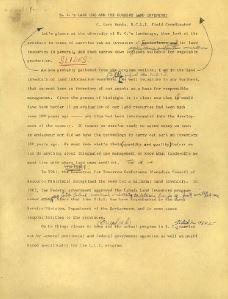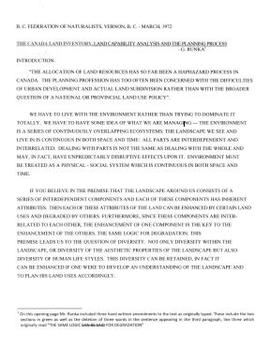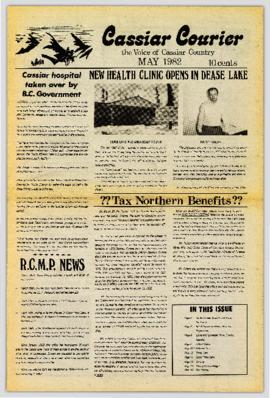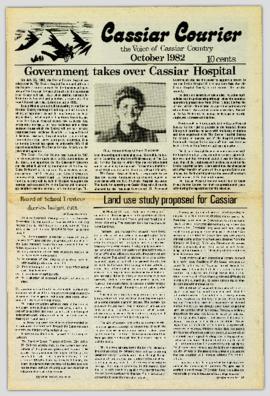File consists of a transcript of an oral history interview with Linda Mueller.
File consists of a transcript of an oral history interview with Ken Sasaki.
File consists of a transcript of an oral history interview with Dennis Spoklie.
File consists of a transcript of an oral history interview with Ralph Spoklie.
File consists of a transcript of an oral history interview with Sandra Trolian.
File consists of a transcript of an oral history interview with Bill Wade.
This document is a contemporary transcription of a Hudson's Bay Company Fort George (New Caledonia) post journal. The accuracy and completeness of this transcription is not verified.
File consists of a transcript of an oral history interview with Cy Bechtel.
File consists of a transcript of an oral history interview with Bob Beeson.
File consists of a transcript of an oral history interview with Buster Brown.
File consists of a transcript of an oral history interview with Mr. and Mrs. Cox.
File consists of a presentation folder containing the Official Report of Debates of the Legislative Assembly (Hansard) from Wednesday, February 12, 2014 Afternoon Sitting (Volume 5, Number 2) which includes a tribute to Gary Runka. Also includes a DVD.
File consists of a speech given by Gary Runka entitled "BC's Land Use and the Current Land Inventory".
Commentary on this speech by Barry Smith of the Ministry of Agriculture and Lands:
"Although page 4 of this speech is missing (or possibly intentionally deleted), this document provides a detailed explanation of the CLI ratings and may well have been the basis of interpretation guidelines for agricultural capability mapping used by the ALC.
GGR at the time was the B.C. Land Inventory Field Coordinator.
It appears that slides at one point accompanied this speech."
File consists of a speech given by Gary Runka at UBC entitled "Integrated Land Use - BC Experience".
Commentary on this speech by Barry Smith of the Ministry of Agriculture and Lands:
"The speech provides insight into GGR's concept of integrated land use as opposed to multiple land use.
Agriculture noted as often the 'primary use for land designated in the ALR'. On page 5 GGR reflects on this concept when stating that integrated land use planning is a useful first step "... to indicate the primary physical capability of each landform based on inherent soil and climatic characteristics".
The speech was accompanied by slides."
File consists of a speech given by Gary Runka to the BC Federation of Naturalists in Vernon entitled "The Canada Land Inventory, Land Capability Analysis and the Planning Process".
Commentary on this speech by Barry Smith of the Ministry of Agriculture and Lands:
"This speech largely avoids technical detail and an outlining of the mechanics of land capability analysis but does provide several practical examples that allow for a better understanding of the application of the analytical work.
The summary on page 11 is particularly important (in part):
"Planning must anticipate desirable land use patterns, not merely react to the pressure of short run expedients. Above all else let's not forget that land use planning should be people-oriented as well as resources-oriented. Hopefully, facts rather than short term
economics, politics, or emotions will play an increasing role in decision-making."
The speech was accompanied by slides.
(Note: Via a handwritten amendment the title was changed from "Land Capability Analysis and the Planning Process" to 'The Canada Land Inventory, Land Capability Analysis and the Planning Process"
File consists of a speech given by Gary Runka entitled "Land Use Planning as it affects the Vegetable Industry".
Commentary on this speech by Barry Smith of the Ministry of Agriculture and Lands:
"GGR gives this speech as a representative of the B.C. Land Commission and is directed at vegetable industry reps.
The ALR is mentioned a number of times and it is noted that only 1 - 2% of BC is suitable for vegetable production. Several examples (8) of pressures on agricultural land are given.
GGR draws his audience's attention to the impact of speculation when stating:
"Substantial capital gain from land development or speculation unfortunately can to some degree subvert even the best planning. .... Fortunately, this type of speculation is now on somewhat shaky ground because of the Land Commission Act in B.C."
The overall message is that vegetable producers should involve themselves in land use planning."
File consists of a speech given by Gary Runka to the BC Federation of Agriculture in Prince George entitled "The Land Commission and the Role of the B.C.F.A. Advisory Committee".
Commentary on this speech by Barry Smith of the Ministry of Agriculture and Lands:
"GGR uses this speech to particularly emphasize the work of the BCFA Regional Advisory Committees appointed to assist the Commission by providing advice.
Several specific examples are given of where the assistance of the Advisory Committees will be helpful.
GGR briefly outlines the work and challenges of the Commission to date. The speech ends with a list of six "general areas of concern". The list is very perceptive, revealing several of the challenges the Commission was facing at this early stage in the program including:
- Breakdown of viable production units through the sale of existing legal parcels;
- Rangeland tenure and management;
- Integrated use complications;
- Impact of major development proposals within or adjacent to the ALR;
- Small holdings owned by non-rural people in the ALR; and
- Urban re-direction away from the ALR and rural / urban interface conflicts.
The last line of p. 5 is partially hidden and reads: "...more than willing to meet with any of you individually as time permits."
File consists of a speech given by Gary Runka entitled "The Preservation of Agricultural Land and the Land Commission Act" at the U.B.C. Symposium for Arable Land: The Appropriate Use of a Scarce Resource. The speech includes the following attachments:
- General Evaluation Criteria for Applications
- Flow Chart - Exclusion Process
- Brief Resume of the types of applications and appeals under the Land Commission Act
Commentary on this speech by Barry Smith of the Ministry of Agriculture and Lands:
"GGR comments on private property rights vs. public interests and the shifting attitudes from seeing land as merely a commodity, to bought, sold and used at will, to recognizing land as a limited natural resource.
He reviews the loss of farmland and outlines how the ALRs were established. A six point list (p. 3) is included of the methodology used to designate the ALR. This is historically an important list because it goes into some detail on the utilization of the C.L.I., the process of designating the ALR plans.
GGR outlines the problems at the time of designation of adjusting the 'natural' CLI boundaries to 'straight' legal boundaries as well as the challenges posed by the scale of mapping.
He comments that applications consume considerable amount of the Commission's resources but efforts are being made to work with local governments on planning issues. GGR closes by listing seven areas of immediate concerns (p. 7).
After 38 years it would be worth reflecting on how many of these "immediate concerns' are still challenging the Commission."
File consists of a speech given by Gary Runka entitled "The British Columbia Experience" for the Planning for Rural Growth event in Whatcom County, Bellingham, Washington.
Commentary on this speech by Barry Smith of the Ministry of Agriculture and Lands:
"This is an important overview document of the farmland preservation program, summarizing the situation after about 6 years since the program's introduction.
There are several interesting points made in the paper - which was given to a non-BC / Canadian audience. A sample of these points included:
- The ALR is based on ecological characteristics of the land and this was very important to the ALR's
success; - The ALR is a long term zone;
- The legislation is not enough - the ALR will not be secure until agriculture and the farming community become an integral part of planning at every level;
- The Langley Properties and work of the Property Management Branch which re-surveying the properties into viable commercial farm units;
- Conflicting priorities of provincial agencies create difficulties;
GGR observes that the Commission has the opportunity "... to have provincial input into planning for agriculture." This is an action, that in due course, the Commission would play a leadership role."
File consists of a speech given by Gary Runka entitled "Future of Intensive Livestock Enterprises in the more densely populated areas of the Agricultural Land Reserve" for the Agricultural Engineering Branch of the BC Ministry of Agriculture.
Commentary on this speech by Barry Smith of the Ministry of Agriculture and Lands:
"In the letter dated December 29,1978, from GGR to Pat Brisbin (Secretary, Engineering Science Lead Committee), GGR refers to the enclosure as "the notes pertaining to my submission" that presumably was made at a meeting of the Engineering Science Lead Committee on December 21,1978.
The thrust of this item is to address the matter of intensive livestock farming in areas within close proximity to urban uses - e.g. in the ALR and along the urban / rural edge.
The 'notes" include a list of twelve "considerations" that should be taken into account when dealing with livestock enterprises on the urban edge.
Six 'actors' and their responsibilities are identified including:
- The Agricultural Land Commission;
- Ministry of Agriculture;
- Local Governments;
- BC Federation of Agriculture;
- Intensive Livestock Operators; and
- Non-farming Public.
It is emphasized that there is a need for communications between these actors and a need for education to avoid conflicts but makes clear that intensive agriculture shall be retained in the ALR.
The paper ends with a series of considerations - Philosophical / Social and Political Pressure / Financing and Tenure / Environmental - Pollution / Waste Disposal.
This paper demonstrates the long standing nature of concerns associated with intensive livestock operations near urban areas and the need for "edge planning"."
File consists of a speech given by Gary Runka entitled "Integrated Natural Resource Management" to the 4th Annual BC Mine Reclamation Symposium in Vernon, BC.
File consists of a speech given by Gary Runka entitled "Overview: Planning for Rural Land" for the Canadian Institute of Planners Annual Conference in Kitchener, Waterloo. Includes newspaper clipping titled "A pathetic tale of two resources" from the Victoria Colonist, June 22,1980.
Commentary on this speech by Barry Smith of the Ministry of Agriculture and Lands:
"This speech is aimed at the "urban" planner who is planning in rural areas. While 'rural land' can encompass many things and there are only passing references to agriculture, the planning approaches and principles - like the need for the urban planner to view the world from the rural side of the fence - is often going to involve agricultural land.
Mention is made of integrated natural resource management and an emphasis is made on the planner understanding the rural perspective.
The comment (warning) is made that "...the rural land use tug-of-war between lifestyle pursuits, population demands and natural resource production will continue" - the message being that planning practitioners will probably find themselves in the midst of these tug-of-wars.
This paper clearly recognizes the challenges of introducing urban planning techniques into rural landscapes and provides some very valuable insights. While farmland preservation isn't central to this speech the rural resource and planning theme is relevant."
File consists of an article written by Gary Runka entitled "Political Realities - Protecting our Dwindling Soil Resource". This was published "Agrologist" magazine (Fall 1980) as "Protecting the soil".
Commentary on this speech by Barry Smith of the Ministry of Agriculture and Lands:
"This paper is focused on the importance of soil conservation. It makes the observation that soil erosion is often not recognized until the damage has been done, but it takes even longer for politicians to be aware of the problem and then for this to translate into policy change. It is noted that this is especially a problem given the short term time horizons of politicians. There is a discussion of what jurisdiction is best to deal with protecting the soil resource. It is emphasized that we no longer have the luxury of time."
File consists of an untitled published piece in Country Life Column by Gary Runka.
Commentary by Barry Smith of the Ministry of Agriculture and Lands:
"This article is focused on renewed interest in the development of a provincial land use strategy. The article outlines the lack of action for over 20 years in the development of such a strategy.
Several key land and water uses that warrant consideration are listed - starting with agriculture - along with a list of overriding issues.
The position of GGR is clear in the last paragraph - 'The time for a provincial land use strategy was yesterday"..
Although farmland preservation is not specifically identified it would, one would have to think, clearly be one element of a land use strategy."
File consists of an untitled published piece in Country Life Column by Gary Runka.
Commentary by Barry Smith of the Ministry of Agriculture and Lands:
"This article focuses a report of the B.C. Round Table on the Environment and the Economy - "A Better Way - Creating a Sustainable Development Strategy for B.C." published in 1990. The thrust of the article concerns the disregard for agriculture in the report. The report identifies six key principles which amount to reasonable objectives / goals but in contrast agriculture fares badly in the report. Three examples are provided of the report's failings with respect to agriculture. Four key questions are asked including, "How can we best protect the limited high capability agricultural land base from alternate use competition?"
File consists of a speech given by Gary Runka entitled "Agricultural Land and Its Management".
Commentary by Barry Smith of the Ministry of Agriculture and Lands:
"This paper has no indication of the audience or date but given that there are several references to 1990 reports, it probably dates to 1991.
Although the scope of this paper is national in several aspects, its primary focus is on the B.C. farmland preservation efforts.
Comment is made on the question of farmland being regarded as a 'commodity' vs 'scarce resource'. GGR draws upon a theme found in other speeches and papers when he notes that 'To some degree, the call for a new "foodland ethic" is based upon the belief that public policy should more adequately take into account the social value of foodlands, quite apart from the dollar value...."
The paper is broken into several sections:
(A) The Setting;
(B) Agricultural Land Loss, (which includes some excellent statistics - p. 2-3)
(C) Some Agricultural Management Issues,
(D) Action Response (this section briefly reviews farmland preservation efforts in each province with a particular emphasis on B.C. p. 5-6),
(E) The Future.
GGR lists the following action steps that BC should pursue:
- Repeal ALC Act appeals to Cabinet;
- Rescind the outright golf course use within the ALR; and
- Introduce Soil Conservation Legislation"
This presentation transcript accompanies the 1973 BC Land Commission photographic slide and audio tape set entitled "Land Commission Act and the Agricultural Reserve Plan" that was used in original public hearings throughout the province. The presentation was given by Bill Lane, BC Land Commission Chair, and Gary Runka, BC Land Commission General Manager.
This paper by Brad Hawkes describes, from a newspaper media's perspective, changes in how fires were fought, reported, and described from 1912-1961 for significant fire years in the Prince George area.
Hawkes, Brad C.Sanborn, P. and R. Brockley. 2005. Sulphur deficiencies in lodgepole pine: occurrence, diagnosis, and treatment. Ext. Note 71. B.C. Min. For., Res. Br., Victoria, B.C.
Unpublished results for the Sulphur stable isotope tracer study (E.P. 886.15) were presented in annual reports to the funding agencies, including this Final Technical Report from April 2007.
Document is a BC Ministry of Forests update on proposed research for the Sulphur stable isotope tracer study (E.P. 886.15) from March 1998.
Document is a research installation layout map for the Holy Cross Creek site of the Sulphur stable isotope tracer study (E.P. 886.15).
This Ministry of Forests internal memorandum of 30 June 1997 from Paul Sanborn to Regional & Research Branch soil scientists provides comparison of Morgan's extractant and BaCl₂ for cations, using the 57 samples from the regional soil mineralogy study.
The key results from the study were later published as:
J.M. Arocena and P. Sanborn. 1999. Mineralogy and genesis of selected soils and their implications for forest management in central and northeastern British Columbia. Canadian Journal of Soil Science 79: 571-592. https://doi.org/10.4141/S98-07
As part of a multidisciplinary team led by Grant Zazula (then a Ph.D. student at Simon Fraser University; later a palaeontologist with the Government of Yukon) and Duane Froese (Professor, University of Alberta), Dr. Paul Sanborn examined a set of buried paleosols (fossil soils) preserved in frozen sediments exposed by placer mining in the spring of 2004.
The findings were published in:
Zazula, G.D., D.G. Froese, S.A. Elias, S. Kuzmina, C. La Farge, A.V. Reyes, P.T. Sanborn, C.E. Schweger, C.A.S. Smith, and R.W. Mathewes. 2006. Vegetation buried under Dawson tephra (25,300 14C yr BP) and locally diverse late Pleistocene paleoenvironments of Goldbottom Creek, Yukon, Canada. Palaeogeography, Palaeoclimatology, Palaeoecology 242: 253–286.
https://doi.org/10.1016/j.palaeo.2006.06.005
The eastern flank of the Mackenzie Mountains has a complex history of multiple glaciations by both the Laurentide and Cordilleran ice sheets, recorded in thick sequences of glacial sediments that were documented at 3 locations (Katherine Creek, Little Bear River, Inlin Brook) by:
Duk-Rodkin, A., R.W. Barendregt, C. Tarnocai, and F.M. Phillips. 1996. Late Tertiary to late Quaternary record in the Mackenzie Mountains, Northwest Territories, Canada: stratigraphy, paleosols, paleomagnetism, and chlorine-36. Canadian Journal of Earth Sciences 33 (6): 875-895. https://doi.org/10.1139/e96-066
Of the 3 sites, the exposure on Inlin Brook, a tributary of the Keele River, was the least well-documented, so in summer 2004 Dr. Paul Sanborn joined a field party of the Geological Survey of Canada (GSC) based at Tulita, NWT, and was given helicopter support to visit Inlin Brook (August 5-8). A brief visit was also made to the Little Bear River site.
On August 9-10, Sanborn joined Alejandra Duk-Rodkin (GSC) and Rene Barendregt (U Lethbridge) in helicopter-assisted field work at sites in the Franklin Mountains and elsewhere east of the Mackenzie River.
The Lost Chicken Mine, a placer gold mine in eastern Alaska, approximately 120 km west of Dawson City, Yukon, is an important fossil locality for the late Pliocene (approximately 2.5 – 3.0 million years ago). A comprehensive account of the stratigraphy and paleontology of this site was given by:
Matthews, J.V., Jr., J.A. Westgate, L. Ovenden, L.D. Carter, and T. Fouch. 2003. Stratigraphy, fossils, and age of sediments at the upper pit of the Lost Chicken gold mine: new information on the late Pliocene environment of east central Alaska. Quaternary Research 60: 9-18. https://doi.org/10.1016/S0033-5894(03)00087-5
Dr. Paul Sanborn visited the site on July 20, 2004, as part of a group led by Duane Froese (Professor, University of Alberta). The group concentrated on a single exposure (~ 2 m thick) straddling the Lost Chicken tephra, a volcanic ash bed (2.9 ± 0.4 myr) which is a major stratigraphic marker at the site. Sanborn described, photographed, and sampled this exposure, and obtained a basic set of characterization data. Intact samples were collected but thin sections were never produced.
This PDF contains site location data, annotated soil profile photographs, and AMS radiocarbon dates for 2008 soil charcoal samples collected at Kluane Lake, Yukon Territory.
This digital document is a scanned PDF of a Prince George Forest Region Forest Research Note #PG-12-1: "Experimental Project 660 - 30-year Progress Report - Buckhorn Installation".
This document is a photocopy of a 1994 draft report prepared by Scagel, Hickling, and Evans for BC Ministry of Forests, Silviculture Branch. The document includes annotations by Lorne Bedford, BC MoF (ret.).
This document contains location and vegetation notes for 5 observation sites for Sanborn's comparative study of grassland soils in the Boreal Cordillera ecozone.
Item is a reproduction of a report entitled "Burns Bog Analysis" by Catherine Berris & Associates for the Ministry of Environment, Lands & Parks. The scope of this Burns Bog Analysis was inventory and preliminary analysis; the process included information collection and review, preliminary analysis of existing and potential land uses and a public open house.
Item is an original wildlife section report by R.W. Ritcey entitled "Predators in Wells Gray Park 1950-1956".
Item is an original "Kwadacha Park 1976" trip report by W.G. Hazelwood. Includes original photographic prints pasted into the report. Also includes a "Kwadacha Wilderness Park Proposal" accompanying map.
Item is a "Stone Sheep Surveys in Muncho Lake and Stone Mountain Provincial Parks" report by W.G. Hazelwood containing photocopied and original pages. Includes original photographic prints pasted into the report.
Item is a photocopied "Report on Mt. Edziza, Tatlatui, Spatsizi" by Bob Henderson.
Item is a draft of "B.C. Hydro Proposed 287 kV Transmission Line - Kitimat to Terrace - Preliminary Environmental Assessment of Fish and Wildlife Values" by Grant Hazelwood. Also includes accompanying print pages for a 2015 BC Hydro powerpoint slideshow regarding the Terrace to Kitimat Transmission Project (TKTP).
This collection encompasses the records of the eJournal "It's Still Winter: A Web Journal of Contemporary Canadian Poetry and Poetics", which was co-published online by College of New Caledonia and the University of Northern British Columbia between 1997 and 2002. The editors of the journal were Don Precosky and Barry McKinnon. The journal published the work of poets from across Canada, but the majority were from northern British Columbia.
The collection contains analogue reproductions of the eJournal issues, drafts and manuscript submissions to the eJournal, and digital records relating to the eJournal (including the website files for the online eJournal).
"The Cassiar Courier" is a newspaper that documents the community and work life of the residents of Cassiar BC. Content includes text and photographs, as well as jokes, comics, and games.
"The Cassiar Courier" is a newspaper that documents the community and work life of the residents of Cassiar BC. Content includes text and photographs, as well as jokes, comics, and games.



